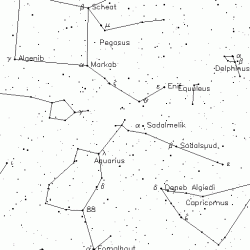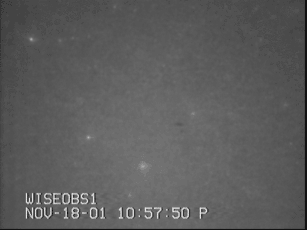Having the New Moon on our side may very well increase your chances of catching a well established meteor shower which is now reaching its peak activity time – the Eta Aquarids. No matter where you live or what time zone you observe from, the best time to look for the offspring of Halley’s Comet is over the next few nights during the hours just before dawn.
Although Comet Halley is located in the outer reaches of our solar system at the moment, its visit in 1986 wasn’t the one that left a particularly dense stream of material which may spark activity of up to 70 meteors per hour for lucky observers in the southern hemisphere. But don’t count yourself out if you live in the north! Around 4:00 a.m. the Aquarius constellation is beginning to rise low to the southeast and rates could be as proliferate as an average of one meteor every three or four minutes. Because the constellation of Aquarius is relatively low for northern observers, this means we have at least better chance of spotting those breathtaking Earth grazers!
Comet Halley is responsible for more than just the Eta Aquarids, however. Particles shed during the comet’s slow disintegration over the millennium are distributed along its orbit and Earth passes through these streams three times a year. The Eta Aquarid, the Beta Aquarids (both in May) and the Orionids (during October). When a piece of this debris enters our atmosphere, it is traveling about 66 kilometers per second and can shine as brightly as the stars (3rd magnitude) in the constellation from which it appears to originate.
 Although meteors can appear from any point in the sky, your best northern skies bet will be to face generally southeast, gaze roughly halfway up the sky and get as comfortable as possible. A reclining lawn chair makes a wonderful meteor watching companion! Getting as far away as possible from city lights will also increase the amount of meteors you see, while just ordinary binoculars will help reveal the twists and turns of the faint trails invisible to the unaided eye. Don’t be discouraged if you’re clouded out or unable to view at this time. The most wonderful part about the Eta Aquarids are the fact that the stream is very broad and the peak activity is drawn out over a period of activity from April 21 until May 12. Around 3:00 a.m., the meteors will first begin penetrating the ionosphere and there is a possibility of strong trails which could last for several seconds. As Aquarius rises higher and dawn approaches, meteor activity is seen “face on”. Like driving through a snowstorm, the meteors will seem to come at you more quickly and give a more streak-like appearance. For those working on your Astronomical League Meteor Challenge lists, be sure to take notes!
Although meteors can appear from any point in the sky, your best northern skies bet will be to face generally southeast, gaze roughly halfway up the sky and get as comfortable as possible. A reclining lawn chair makes a wonderful meteor watching companion! Getting as far away as possible from city lights will also increase the amount of meteors you see, while just ordinary binoculars will help reveal the twists and turns of the faint trails invisible to the unaided eye. Don’t be discouraged if you’re clouded out or unable to view at this time. The most wonderful part about the Eta Aquarids are the fact that the stream is very broad and the peak activity is drawn out over a period of activity from April 21 until May 12. Around 3:00 a.m., the meteors will first begin penetrating the ionosphere and there is a possibility of strong trails which could last for several seconds. As Aquarius rises higher and dawn approaches, meteor activity is seen “face on”. Like driving through a snowstorm, the meteors will seem to come at you more quickly and give a more streak-like appearance. For those working on your Astronomical League Meteor Challenge lists, be sure to take notes!
Don’t let anyone discourage you from watching the Eta Aquarids if you have an opportunity. While it isn’t one of the most prolific showers of the year, it is very well established and dark skies will help tremendously during this apparition. It has been my experience over the last 20 or so years to at least see a few during an observing session and come away feeling very happy indeed that I took the time to look for Comet Halley’s children racing by.
Good luck and clear skies…
The awesome image of the meteor was taken by D. Polishook, N. Brosch, & I. Manulis (Tel-Aviv U., Wise Obs.), and Spacegaurd Israel and supplied by NASA.


This time I let Nature do the talking: Even under the best conditions no observer saw more than 15 Etas per hour and most only a handful. For comparision, during the Per and Gem a single observer can see several hundred meteors during peak night, clear & dark skies provided. As for watching “Halley’s children”, the Orionids are a better bet, esp. since they are unusually active these years.
Readers:
Don’t let Daniel Fischer discourage you from following meteor showers. There are many ways to follow a meteor shower – including watching ionospheric disturbances and listening to radio meteor scatter. Becoming a good visual observer takes practice and every meteor shower produces different results. For example, the spectral signature of a Leonid won’t be the same as a Geminid… and the same holds true of its visual appearance and fall rate. It’s very unfair of Mr. Fischer to discourage you from watching any meteor shower except the major ones… Look at all the opportunities you’d miss!
Thanks for the post, Ian! Both myself and Ian O’Neill from UT were viewing remotely and we definately watched the ionosphere turn to swiss cheese during that time frame. I followed it for several hours until it went across central Africa and produced the same results. I’ve also got quite a few hours of meteor scatter to listen to from various points around the earth – with equally good results. Although Central Victoria was clouded out at the time, I accessed radio information from Macedon Ranges Observatory where we recorded meteor scatter live. The staff at MRO are real pros!
Although I’m 42 N, I still saw a couple dozen, including some extremely nice earth grazers, between 3:30 and 5:30. As an astronomy outreach educator and highly accredited observer, I would suggest readers ignore Daniel’s poor suggestions and take an example from our friends at Ice In Space and Macedon Ranges Observatory…
Go look… And listen! 😉
Hello! I was wondering if anybody could tell me what is the best time to watch for it in Easter Standard Time zone? Thank you!
We had a great view of the Eta Aquarids here in northern Australia.
My best rate was 45/hour here in the Northern Territory.
Some folks have seen over 50/hour !
I have set up a poll on the iceinspace forum at
http://www.iceinspace.com.au/forum/showthread.php?t=31390
Hope you had a great view of the Eta Aquarids, post your results on iceinspace.
pssst… julia… sorry, sweetie!
“No matter where you live or what time zone you observe from, the best time to look for the offspring of Halley’s Comet is over the next few nights during the hours just before dawn.”
Sadly, Tasmanian skies in the south-east were clouded out – what’s new!!
Great to see Bert at MRO continuing to make a real contribution on the International astronomy scene, with his team of experts really hitting top scores. Keep it up you guys & clear skies.
Shevill Mathers
Southern Cross Observatory 42 South
Thanks Tammy for the positive reply to Mr Negative, Daniel Fischer’s comments.
Sad to see people like this posting. Newcomers to our hobby could find this sort of attitude confusing and may be turned away forever from experiencing one of the greatest sights in the night sky.
Well done Bert and the Macedon Ranges Observatory crew – you guys are kicking goals on the world scene. Keep up the good work on the forum too.
Dave Reneke
I thank both you gentlemen.
It’s a real pleasure to work with an observatory which let’s you tap directly into their information and share findings with the general public. MRO is far more than “just a forum”, it’s a staff of extremely professional dedicated astronomers…
And dang nice people, too.
Hi Tammy,
I agree, a very welcome & refreshing new direction, I can only see this attracting more contributors with real contributions to make at all levels.
Clear skies to all,
Shevill-Tasmania 42 South